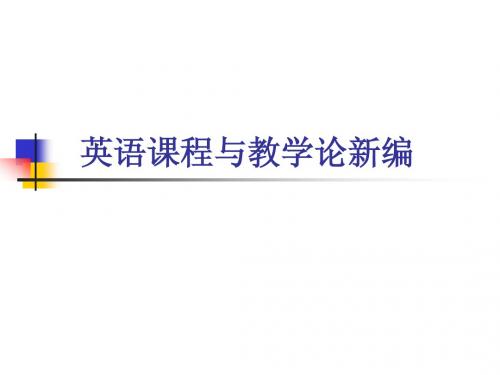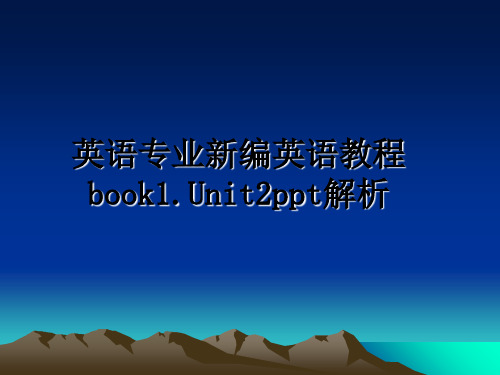英语课程与教学论新编PPT课件
合集下载
新编英语教程3课件

Course outline
01
02
03
Unit 1
Introduction to the course and basic communication skills
Unit 2
Intermediate
communication skills
and
cultural
understanding
Unit 3
various methods, such as word formation, synonyms and
antonyms, and contextual learning.
Writing skills
Paragraph development
This module teaches students how to develop paragraphs by introducing a topic, presenting evidence or examples, and结论.
Writing Practice
Composition assignments
Students are given various writing assignments to practice their writing skills, including short essays, paragraph development exercises, and letter writing.
Peer review
Students are encouraged to review and provide feedback on each other's writing to improve their understanding of good writing practices and to learn from each other's mistakes and successes.
英语课程与教学论(1)

(2)Theory of learning
The theory of learning underlying the Grammar-Translation Method was Faculty Psychology.
3. Basic Principles
(1)Main features (2)Objectives (3)Techniques (4)Exemplification
The Grammar-Translation Method
1. 2. 3. 4. Background Theoretical Basis Basic Principles Summary and Comments
1. Background
(1)The history of the Grammar-Translation Method is not fully and carefully documented. However, there is evidence that grammar analysis and translation began to be the basic procedures in foreign language teaching from the 16th century. (2)The second impetus for the procedures of grammar analysis and translation in teaching Latin came from the social needs of European countries.
英语课程与教学论新编
Chapter 12
Schools of English Teaching Methodology
新课标英语课程标准PPT教学课件

发展个性, 提高人文素质
英语
工具性
全
面
发
展
人文性
一个途径 二个评价 二个过程
四个任务
五个方面 九个等级
任务型教学途径
形成性和终结性评价并重
英语课程教学过程既是培养综合 语言运用能力的过程,也是培养 学生健全人格的过程
培养学生的学习兴趣、培养语言综合 运用能力、培养创新能力和培养跨文 化意识
语言技能、语言知识、情感态度, 学习策略和文化意识
略略略略
综合语言 运用能力
文文跨 化化文 知理化 识解交
际
语言技能
听说读写
语言知识
语词语功话 音汇法能题
语言知识
语音
(Appendix1, p51-52)
词汇
(Appendix7, p96-234)
语法
(Appendix2, p53-55)
功能 话题
(Appendix3, p56-78) (Appendix4, p79-p86)
实施建议:
语言知识
1. 可以采用提示、注意和观察、发现、分析、归纳、对比、 总结等方式进行
2. 杜绝单纯传授、讲解语言知识的做法,语音、词汇、语 法任何一项都不是语言,也不能起语言作为交际工具的 作用。
3. 语言运用的真实情景中学习 (任务型教学)
语言知识
Clarifying a myth: 新课标提倡探究式学习并不是排除语言
语言知识 情感态度 学习策略 文化要求
语言技能: 听说读写
语言技能
听说
读写
• 都是学习的内容,目标,和手段 • 都涉及语言运用和语言转换
• 通过语言活动理解和吸 收的技能
• 由外部语言转换为内部 语言
英语
工具性
全
面
发
展
人文性
一个途径 二个评价 二个过程
四个任务
五个方面 九个等级
任务型教学途径
形成性和终结性评价并重
英语课程教学过程既是培养综合 语言运用能力的过程,也是培养 学生健全人格的过程
培养学生的学习兴趣、培养语言综合 运用能力、培养创新能力和培养跨文 化意识
语言技能、语言知识、情感态度, 学习策略和文化意识
略略略略
综合语言 运用能力
文文跨 化化文 知理化 识解交
际
语言技能
听说读写
语言知识
语词语功话 音汇法能题
语言知识
语音
(Appendix1, p51-52)
词汇
(Appendix7, p96-234)
语法
(Appendix2, p53-55)
功能 话题
(Appendix3, p56-78) (Appendix4, p79-p86)
实施建议:
语言知识
1. 可以采用提示、注意和观察、发现、分析、归纳、对比、 总结等方式进行
2. 杜绝单纯传授、讲解语言知识的做法,语音、词汇、语 法任何一项都不是语言,也不能起语言作为交际工具的 作用。
3. 语言运用的真实情景中学习 (任务型教学)
语言知识
Clarifying a myth: 新课标提倡探究式学习并不是排除语言
语言知识 情感态度 学习策略 文化要求
语言技能: 听说读写
语言技能
听说
读写
• 都是学习的内容,目标,和手段 • 都涉及语言运用和语言转换
• 通过语言活动理解和吸 收的技能
• 由外部语言转换为内部 语言
英语教学理论ppt课件

100年以来,中国在外语教学中所使用教学法, 都是国外进口的,主要包括:
1 语法翻译法Grammar Translation Method 2 直接法Direct Method 2 情景法 Situational Method 3 听说法Audio-lingual Method 4 视听法Audio-Visual Method 5 交际法Communicative Method 6 任务法Task-based Method 7 全身反应法Total Physical Response 8 认知法Cognitive Method
心理学对英语教学法的影响 • 学习心理学理论的影响
• 斯金纳:操作条件反射论 • 布鲁纳:认知发现学说
• 心理语言学的影响
• 图示理论——外语阅读中的相互作用模式
8
第2章 外语教学法的主要流派
Lorem ipsum dolor sit amet, consectetur adipisicing elit, sed do eiusmod tempor incididunt ut labore et dolore magna aliqua. Ut enim ad minim veniam, quis nostrud exercitation ullamco laboris nisi ut aliquip ex ea commodo consequat.
11
语法翻译法 Grammar Translation Method
语法翻译法是一种通过学习语法规则和词汇,并且按照规则
用本国语和目的语进行互译来教授语言的方法。
12
语法翻译法 Grammar Translation Method
语法翻译法的教学方法 1. 课堂管理采用教师权威模式,教学是教师向学生灌 输知识的单向行为。学生很少提问,学生之间交流更 少。 2. 文学语言优于口语;在听、说、读、写四技能中, 重视读写,轻视听说。 3. 课堂用语大部分是母语。通过翻译检查教学质量。 采用方式有单句填空、造句、背诵课文和作文等。
1 语法翻译法Grammar Translation Method 2 直接法Direct Method 2 情景法 Situational Method 3 听说法Audio-lingual Method 4 视听法Audio-Visual Method 5 交际法Communicative Method 6 任务法Task-based Method 7 全身反应法Total Physical Response 8 认知法Cognitive Method
心理学对英语教学法的影响 • 学习心理学理论的影响
• 斯金纳:操作条件反射论 • 布鲁纳:认知发现学说
• 心理语言学的影响
• 图示理论——外语阅读中的相互作用模式
8
第2章 外语教学法的主要流派
Lorem ipsum dolor sit amet, consectetur adipisicing elit, sed do eiusmod tempor incididunt ut labore et dolore magna aliqua. Ut enim ad minim veniam, quis nostrud exercitation ullamco laboris nisi ut aliquip ex ea commodo consequat.
11
语法翻译法 Grammar Translation Method
语法翻译法是一种通过学习语法规则和词汇,并且按照规则
用本国语和目的语进行互译来教授语言的方法。
12
语法翻译法 Grammar Translation Method
语法翻译法的教学方法 1. 课堂管理采用教师权威模式,教学是教师向学生灌 输知识的单向行为。学生很少提问,学生之间交流更 少。 2. 文学语言优于口语;在听、说、读、写四技能中, 重视读写,轻视听说。 3. 课堂用语大部分是母语。通过翻译检查教学质量。 采用方式有单句填空、造句、背诵课文和作文等。
《新编英语教程》PPT课件

h
23
6. Well
A seemingly ordinary but actually magic word!!!
h
24
Discussion/Exercises
Free debate
Are you for or against the opinion that to learn English is to learn the formal and standard English?
whereas—but; on the other hand. This is used to introduce contrast.
More examples: The Longs lived in a house, whereas Tom’s uncle and aunt lived in
h
20
5. many ? Much
Do you have more precise and effective way to give the description of numbers?
h
21
vast quantities of —lot of
To express the idea of many, the following words and phrases can be used:
新编英语教程4
For your promising future
h
1
Unit Two
h
2
Objectives
1. to get familiar with the features of an exposition
2. to learn the usage of euphemism in English
最新英语专业新编英语教程book1.Unit2ppt解析PPT课件

镇最差花园的小奖! 7. Every year I enter for the garden
competition too, and I always win a little prize for the worst garden in the town!
4. give a lecture on …: 作一个关于…的讲座
B. when is Thanksgiving Day C. which animal does he like best D. what time will the dolphin show start
7. Miss Li wants to know _____ next week. A. when my uncle leaves B. when will my uncle C. where my uncle will stay D. where does my uncle stay
9. stay away from: 离开,外出 1. (1)远离毒品! 2. Stay away drugs! 3. (2)离我远一点! 4. Stay away from me! 5. (3)stay away from school
10. come last: 排在最后 1. come first: 排在最前 2. come before: 排在…之前 3. come next to: 排在…之后
11. care about: 担心,在意 1. care for: 照顾(= take care of); 愿意
(want) 2. (1)当他生病时,他的儿子照顾他。
3. His son cared for him when he was ill. 4. (2)你要多注意你的衣着!
competition too, and I always win a little prize for the worst garden in the town!
4. give a lecture on …: 作一个关于…的讲座
B. when is Thanksgiving Day C. which animal does he like best D. what time will the dolphin show start
7. Miss Li wants to know _____ next week. A. when my uncle leaves B. when will my uncle C. where my uncle will stay D. where does my uncle stay
9. stay away from: 离开,外出 1. (1)远离毒品! 2. Stay away drugs! 3. (2)离我远一点! 4. Stay away from me! 5. (3)stay away from school
10. come last: 排在最后 1. come first: 排在最前 2. come before: 排在…之前 3. come next to: 排在…之后
11. care about: 担心,在意 1. care for: 照顾(= take care of); 愿意
(want) 2. (1)当他生病时,他的儿子照顾他。
3. His son cared for him when he was ill. 4. (2)你要多注意你的衣着!
英语教学论教程 ppt课件

英语教学论教程 ppt课件 englishteaching methodology introduction yangchunling ppt课件names course1)methodology englishteaching 2)methodology englishteaching middleschool/secondary school 3)teaching english foreignlanguage englishlanguage teaching englishteaching methodology methodsused englishteaching. teachingrules middleschool, which guideour teaching students?communicative competence. hymes,communicative competence included four aspects: grammatically acceptable, understandable,social norms,actually use) ppt课件teaching helpsomeone acquire, changesome skills, attitude, knowledge, ideas, otherwords, teacher?stask influencedesirable changes tendenciestoward behavior, hisstudents. nationalenglish curriculum. ii.how goodenglish teacher? iv.topics vi.course requirements. nationalenglish curriculum. ppt课件overall language ability affect learning strategies cultuarl awareness language skills language knowledge international perspectiveness patriotism confidence motivation cognitive self management communication resourcing knowl
小学英语新课程教学设计与案例分析PPT课件

3、会话教学
1) 注重呈现的多样性和趣味性 2) 注重教学过程 3) 通过任务型活动来巩固、活用语言 4) 注重话题的拓展
第33页/共57页
任务型教学活动的设计
1、什么是任务型教学 2、四种常用的任务类型 3、任务设计应注意的问题
第34页/共57页
1、什么是任务型教学
任务型教学是指在教学活动中设定一定的任务,让学生在完成任务的过程中习 得语言知识,进而培养学生的交际能力。它是以具体的任务为学习动力或动机,以完 成任务的过程为学习过程, 以展示任务成果的方式来体现教学的成就的教学活动。
第41页/共57页
Happy birthday!
第42页/共57页
6)任务设计要贴近学生的生活和经验
教师设计任务时要充分考虑到贴近学生的生活和经验,包括自然的生活经验和 心理生活经验。学生对于贴近他们生活经验的任务,会很积极、很自信投入其中, 并享受其中。教师在这种任务的实施过程中能得到事半功倍的效果。
第8页/共57页
五、教学设计的技巧
(一)如何分析教材 (二)如何分析学生 (三)如何设计教学目标 (四)如何设计教学媒体 (五)如何设计课堂组织形式 (六)如何设计教学方法
第9页/共57页
一1、定分的析高教度材来前(研,究一要和对)分《析如英教语何材课。分程标析准教》进材行研究,把握《课标》对小学英语的教学要求 ,这样才能站在
第36页/共57页
3、任务设计应注意的问题
1)任务设计要有明确的目的 教师在设计任务时,应做到有明确的目的性,不是为了设计任务而设计任务,
而是应该以完成某项教学目标去设计这项任务,使学生在任务完成的过程中能有所 收获。
教师在设计任务时,应以意义为中心,而不是以操练某种意义不大甚至无意义 的语言形式为目的。
- 1、下载文档前请自行甄别文档内容的完整性,平台不提供额外的编辑、内容补充、找答案等附加服务。
- 2、"仅部分预览"的文档,不可在线预览部分如存在完整性等问题,可反馈申请退款(可完整预览的文档不适用该条件!)。
- 3、如文档侵犯您的权益,请联系客服反馈,我们会尽快为您处理(人工客服工作时间:9:00-18:30)。
⑴to read and translate its literature; ⑵to understand the target language; ⑶to help develop their minds; ⑷to gain a better understanding of the first
6.The sentence is the basic unit of language teaching and learning.
nguage accuracy is emphasized.
CHENLI
8
(2)Objectives
The objectives of learning a foreign language in a Grammar-Translation Method classroom are to enable the learners:
3.The major practice is translating from and into the target language.
4.The teaching focus is reading writing.
5.First language is the main medium of instru903 赵蒙 020901101
CHENLI
1
Schools of English Teaching Methodology
The Grammar-Translation Method The Direct Method The Audio-lingual Method The Cognitive Approach The Communicative Approach Task-based Language Teaching
CHENLI
2
The Grammar-Translation Method
1.Background 2.Theoretical Basis 3.Basis Principle 4.Summary and Comments
CHENLI
3
1.Background
(1)The history of the Grammar-Translation Method is not fully and carefully documented. However, there is evidence that grammar analysis and translation began to be the basic procedures in foreign language teaching from the 16th century.
CHENLI
7
(1)Main features
1.Grammar is the core of language, and language materials are arranged according to the grammar system.
2.The main teaching activities are analysis, explanation and translation.
⑵The second impetus for the procedures of grammar analysis and translation in teaching Latin came from the social needs of European countries.
CHENLI
4
1.Background
language.
CHENLI
9
(3)Techniques
⑴Reading ⑵Translation ⑶Deductive teaching of grammar ⑷Analysis and comparison ⑸Memorization ⑹Reading comprehension questions ⑺Written work
(4)In the 19th century, more experts of foreign language teaching adopted the strategy of combining grammar rules with translation and the Grammar-Translation Method became the principal method of teaching modern languages in schools.
The theory of learning underlying the Grammar-Translation Method was Faculty Psychology.
CHENLI
6
3.Basis Principle
(1)Main features (2)Objectives (3)Techniques ( 4 ) Exemplification
⑶Some people believed that the mind of human beings could be trained by logical analysis of the classic language, extensive memorization of complicated rules and paradigms and translation between languages.
CHENLI
5
2.Theoretical Basis
(1)Theory of language
The theory of language underlying the Grammar-Translation Method was derived from Comparative Historical Linguistics. (2)Theory of learning
6.The sentence is the basic unit of language teaching and learning.
nguage accuracy is emphasized.
CHENLI
8
(2)Objectives
The objectives of learning a foreign language in a Grammar-Translation Method classroom are to enable the learners:
3.The major practice is translating from and into the target language.
4.The teaching focus is reading writing.
5.First language is the main medium of instru903 赵蒙 020901101
CHENLI
1
Schools of English Teaching Methodology
The Grammar-Translation Method The Direct Method The Audio-lingual Method The Cognitive Approach The Communicative Approach Task-based Language Teaching
CHENLI
2
The Grammar-Translation Method
1.Background 2.Theoretical Basis 3.Basis Principle 4.Summary and Comments
CHENLI
3
1.Background
(1)The history of the Grammar-Translation Method is not fully and carefully documented. However, there is evidence that grammar analysis and translation began to be the basic procedures in foreign language teaching from the 16th century.
CHENLI
7
(1)Main features
1.Grammar is the core of language, and language materials are arranged according to the grammar system.
2.The main teaching activities are analysis, explanation and translation.
⑵The second impetus for the procedures of grammar analysis and translation in teaching Latin came from the social needs of European countries.
CHENLI
4
1.Background
language.
CHENLI
9
(3)Techniques
⑴Reading ⑵Translation ⑶Deductive teaching of grammar ⑷Analysis and comparison ⑸Memorization ⑹Reading comprehension questions ⑺Written work
(4)In the 19th century, more experts of foreign language teaching adopted the strategy of combining grammar rules with translation and the Grammar-Translation Method became the principal method of teaching modern languages in schools.
The theory of learning underlying the Grammar-Translation Method was Faculty Psychology.
CHENLI
6
3.Basis Principle
(1)Main features (2)Objectives (3)Techniques ( 4 ) Exemplification
⑶Some people believed that the mind of human beings could be trained by logical analysis of the classic language, extensive memorization of complicated rules and paradigms and translation between languages.
CHENLI
5
2.Theoretical Basis
(1)Theory of language
The theory of language underlying the Grammar-Translation Method was derived from Comparative Historical Linguistics. (2)Theory of learning
